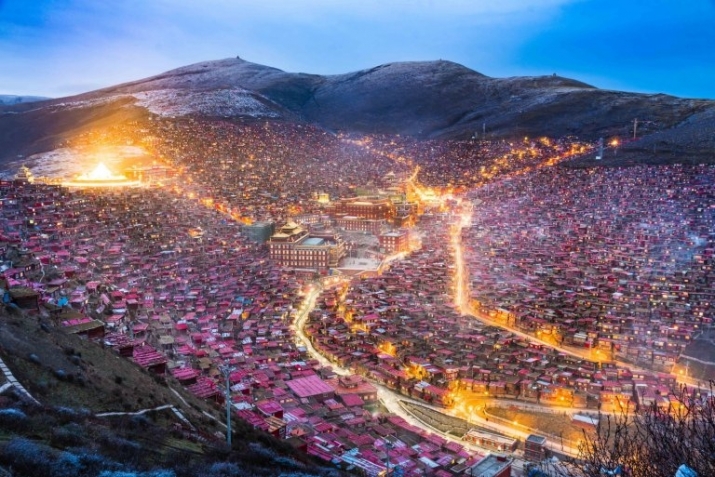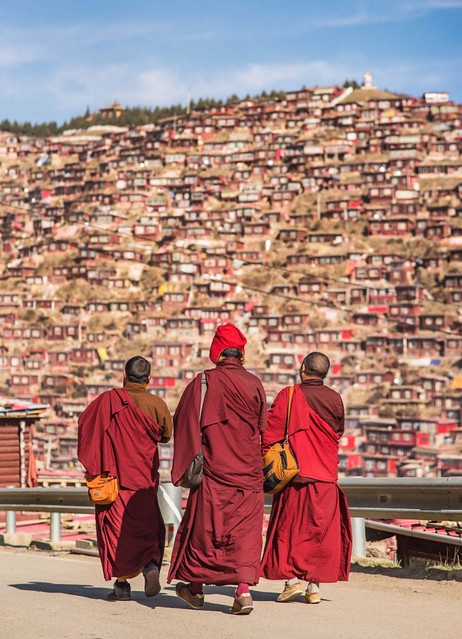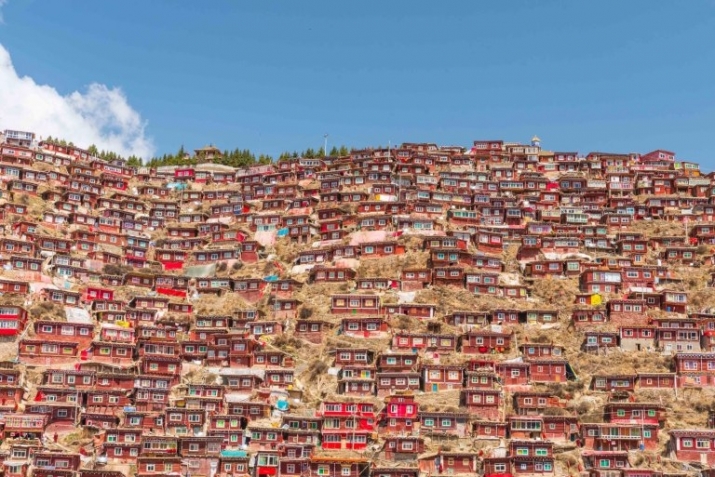NEWS
Chinese Authorities Plan Major Reduction of Monastic Population at Larung Gar
 Thousands of cabins housing Larung Gar's monastic community line the hillsides surrounding the institute. Photo by Jesse Earl Rockwell. From metro.co.uk
Thousands of cabins housing Larung Gar's monastic community line the hillsides surrounding the institute. Photo by Jesse Earl Rockwell. From metro.co.ukThe authorities in China’s southwestern Sichuan Province are reportedly planning a major reduction of the burgeoning monastic population at the famed Larung Gar Buddhist Academy in the Larung Valley near the town of Sertar, Garze Prefecture. The reported decision follows similar moves in 2001, when state authorities organized a mass eviction of residents from the institute, and late last year, when further evictions were accompanied by an order to reduce admissions to curb the rapid growth of the monastic population.
Situated in the traditional Tibetan region of Kham, Larung Gar Buddhist Academy was founded in 1980 by the highly respected teacher Khenpo Jigme Phuntsok (1933–2004), a lama of the Nyingma tradition, one of the four major schools of Tibetan Buddhism. With some estimates putting the population at as many as 40,000 monks and nuns, the institute is widely considered to be the largest center of Buddhist learning in the world.
“Last year, 600 members of this center were ordered to leave, and they returned to their hometowns. About 400 members aged 60 and older were also asked to leave, and they left as well,” an anonymous source told Radio Free Asia, a private, non-profit international broadcaster created by the US government. “This year, the authorities are talking about 1,200 members who will have to leave, and it is said that China has now issued a document saying that only 5,000 monks and nuns will be allowed to remain [at Larung Gar].”
Government officials were marking houses that obstructed the passage of firefighting vehicles or the construction of roads, according to the source, who added that dwellings targeted for demolition would be torn down by force if necessary. “About 60 to 70 per cent of the houses of monks and nuns are being marked for demolition,” the source said, noting that the order to reduce the number of residents at Larung Gar did not originate at the county level, "but comes from higher authorities,” with China’s president Xi Jinping taking a personal interest in the matter. (Radio Free Asia)

Some estimates put the monastic population of Larung Gar Buddhist
Academy at high as 40,000 monks and nuns. Photo by Jesse Earl
Rockwell. From metro.co.uk
In 2001, government authorities had become unsettled by the rapid population growth at the institute. Alarmed by what they termed “splittist” activities, and particularly unnerved by its growing popularity among ordinary Han Chinese—at the time, Han Chinese at the academy numbered more than 1,000—the authorities sent in thousands of security personnel and laborers, who evicted all but 1,400 of the monastery’s 9,000 inhabitants and razed 2,400 dwellings. Many of the nuns and monks turned out from Larung Gar made their way southwest to the more remote Yarchen Gar monastic community, still largely hidden from the outside world by its geographical remoteness and political restrictions put in place by the government. Because of these restrictions, most of the monks and nuns at Yarchen Gar are not officially recognized and live in fear of eviction.
The site of the Larung Gar Buddhist Academy was chosen by Khenpo Jigme Phuntsok because of its historical connection to the Vajrayana tradition. It is said that His Holiness the first Dudjom Rinpoche, Dudjom Lingpa (1835–1904), stayed here with his 13 disciples. The institute was conceived as an independent center of study that would help revitalize the Dharma and revive the study and practice of Tibetan Buddhism following the devastating impact of China’s Cultural Revolution (1966–76), during which Tibetan Buddhism was suppressed and thousands of monasteries were destroyed. While the academy initially had fewer than 100 students, the monastic population grew rapidly in the years that followed.
The institute has played a key role in revitalizing the teachings of Tibetan Buddhism since China eased restrictions on religious practice in 1980, and has become renowned for the quality of both its religious and secular education. English, Chinese, and Tibetan languages and modern computer studies are taught alongside a traditional non-sectarian Buddhist curriculum. About 500 khenpos—holders of doctoral degrees in divinity—have studied at Larung Gar Buddhist Academy.
 Photo by Jesse Earl Rockwell. From metro.co.uk
Photo by Jesse Earl Rockwell. From metro.co.ukSee more
Massive Cuts Planned For Tibetan Buddhist Center in Sichuan (Radio Free Asia)
In pics: The world’s most densely packed halls of residence (Metro)
Larung Gar Nuns Push for Gender Equality in Tibetan Buddhism (Buddhistdoor Global)
Nuns at Yarchen Gar Monastery in Sichuan Province Defy Poverty in Pursuit of Learning (Buddhistdoor Global)
Chinese Government Orders Larung Gar Buddhist Institute to Reduce Admissions (Buddhistdoor Global)
The Wonders of Kham and Larung Gar (Buddhistdoor Global)
The Wonders of Kham and Larung Gar, Part Two (Buddhistdoor Global)














